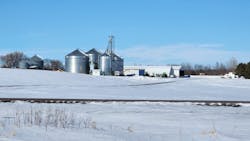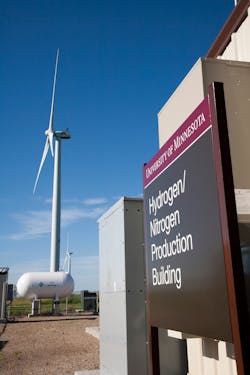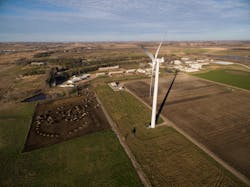For Runestone Electric Association, agricultural activities always have been an important consideration in electric grid operations and planning. Farmland accounts for a large portion of its service territory in west central Minnesota. In recent years, it has had to keep a particularly close eye on large loads from crop drying.
For about six weeks during harvest season, numerous farms across the region use large electric fans to dry corn and soybeans. The drying process also relies on electric augers to transport dried crops to silos for storage. In 2016, Runestone Electric Association (REA) had to build a new substation after experiencing persistent voltage problems because of the concentration of crop-drying in a 10-sq-mile (26-sq-km) area. Existing grid infrastructure could not accommodate the loads.
Investing in a new substation is not an ideal solution to serve a six-week load. Given that similar challenges could emerge in other areas, REA has been exploring alternative ways to defer or avoid such investments. One promising approach involves the use of portable engines powered by zero-carbon, or green, ammonia. While most ammonia worldwide is made with processes that use fossil fuels, green ammonia is produced with renewable energy.
Green Ammonia’s Potential
REA and its wholesale power supplier Great River Energy (GRE) have learned about green ammonia’s potential through the University of Minnesota’s West Central Research & Outreach Center (WCROC), which conducts applied agricultural research for farmers and rural communities. In 2013, WCROC — located just an hour’s drive from REA’s headquarters — commissioned a first-of-its-kind facility that produces green ammonia with wind power. WCROC is currently building a larger-scale version of the facility.
How To Dispatch Optimally
A researcher in the University of Minnesota’s department of chemical engineering and materials science, Qi Zhang is modeling how to schedule dispatch of ammonia gensets optimally so REA can defer grid infrastructure investments for several years. The idea is to enable REA to move around a limited number of gensets to serve a larger number of short-duration loads. This approach could help REA to reduce its upfront capital costs for the gensets.
REA and GRE also shared qualitative descriptions of other disruptive loads expected in the future. One involves clusters of vacation homes that surround numerous lakes in REA’s service territory. On Friday afternoons in the summer, throngs of visitors arrive at the lakes, turn on air conditioners and cook dinner with electric ranges and ovens.
While these residential loads have not overloaded the grid yet, they could become problematic for a few busy weekends each summer as more vacationers charge electric vehicles upon arrival. Ammonia gensets are a particularly attractive solution because the cost of building new lines in these areas is high.
The researchers are evaluating whether grid-connected gensets could address the lake scenario in the summer and then be transported to other locations. For example, a genset could be used in lake country for the July 4th holiday and other high-demand summer weekends and then moved 60 miles (97 km) to the far western part of REA’s grid to serve crop-drying loads in the fall. During other times of the year, the genset could be connected to the grid at strategic locations to reduce wholesale market purchases when prices are high. This could be particularly impactful during high-demand periods.
Zhang’s team provided REA and GRE with sample genset dispatch schedules. REA and GRE have reviewed the schedules and suggested the team revisit the analysis to account for in-field operational factors, such as genset start-up times, the amount of time gensets are needed at specific locations and the logistics of supplying ammonia. This collaborative approach has helped to refine the analysis.
According to the research, with a few portable, strategically located gensets, REA could shave problematic local peaks and defer investments for several years. Furthermore, when it did move forward on a capital investment, a genset would be available for the next emerging problem.
Developing Ammonia Gensets
In parallel, REA and GRE are collaborating with the University of Minnesota’s department of mechanical engineering’s Will Northrop and Seamus Kane, who are developing gensets to be tested on REA’s system. Prior research by Northrop and Kane has shown ammonia can be used as fuel for spark-ignition engines. However, to optimize the fuel for combustion, the engine needs to convert about 10% of the ammonia to hydrogen. Their next research step is to develop an engine that runs on 100% ammonia.
REA has provided the researchers with its preferences on the genset’s operational features. These include portability, the ability to run for multiple days at a time and the ability to easily transport ammonia to the genset site.
REA and GRE have given Northrop and Kane a valuable perspective on the unique power delivery requirements in rural regions, where electric cooperatives typically use trailers to transport gensets over long distances. This information enabled the researchers to adapt their ammonia genset design for rural areas, thereby significantly broadening the potential number of applications for the technology.
Commercialization is close. Northrop and Kane plan to demonstrate their first 250-kW ammonia-fueled genset in 2024. WCROC’s production facility will supply the green ammonia for field tests on REA’s grid.
In the meantime, Northrop and Kane are developing safety measures to prevent ammonia leaks and minimize harmful emissions. While ammonia-powered gensets have no carbon dioxide or particulate emissions, they can emit nitrogen oxides (NOx), nitrous oxide and ammonia. The researchers’ work to date has shown optimizing the ammonia combustion process can reduce NOx emissions to levels comparable to that of a diesel engine. They are working with a catalyst supplier to reduce combustion emissions of NOx, nitrous oxide and ammonia to near zero.
Northrop and Kane expect ammonia gensets to take 30 seconds to 120 seconds to ramp up to full power — like fossil-powered gensets. Ramp-up may be a bit longer when ambient temperatures drop below 0°F (-18°C).
The researchers expect ammonia and fossil gensets to have comparable maintenance costs as well, though ammonia gensets potentially offer some advantages on maintenance. Unlike diesel and gasoline, ammonia fuel does not degrade or produce ash and soot when burned in engines. As a result, oil in the genset is less likely to foul, or become dirty, and can last longer. That said, the researchers have not conducted long-term run experiments on ammonia gensets and concede there is still more to learn about their durability.
According to Kane, a utility would need about 6200 gal (23,470 liters), or 16 tons, of ammonia to run a 250-kW ammonia genset for 100 hours continuously. A semitruck could transport to the genset site nearly double this amount with an 11,500-gal (43,532-liter) tank on a trailer. The truck can refill a genset’s fuel tank while the genset is generating power.
Synergies With Agriculture
The Midwest’s agricultural industry relies heavily on fertilizer made with conventional, fossil-based ammonia. As a result, the region already has extensive, mature infrastructure for safe, reliable ammonia handling, storage and transport. Ammonia safety is important because the material can be corrosive and toxic if inhaled.
For REA, GRE and other Midwest utilities exploring green ammonia applications, intriguing possibilities exist for collaboration with agricultural entities and fertilizer companies on ammonia production, storage, transport and use.
For one, the timing of ammonia use across the utility and agricultural sectors is potentially complementary. REA would need ammonia in the summer for lake country, fall for crop drying and winter for areas with high heating demand — times of the year when farms typically do not use fertilizer. Spring is the peak fertilizer season for farming. What is more, conventional ammonia potentially can be replaced with green ammonia without significantly disrupting agricultural operations.
A team of University of Minnesota researchers have envisioned a system that couples the agricultural and energy sectors by taking advantage of the synergies between them. The system would use renewable energy for several applications across the two sectors:
- Produce ammonia for fertilizer, tractor fuel and crop drying
- Serve local electricity demand
- Export excess power to the grid.
For such a system to work, its design and scheduling would need to be optimized carefully to account for the variability of renewable generation as well as variable power and ammonia demand across hourly and seasonal time scales. The researchers have demonstrated the promise of an optimization approach. The demonstration used a case study in which wind turbines serve demand for ammonia fertilizer and fuel at WCROC’s farm as well as serve electric demand at the adjacent University of Minnesota campus in Morris.
For GRE, green ammonia production offers a potential opportunity to absorb excess wind generation on its transmission grid, balance energy supply and demand, and avoid back-feeding because of high wind penetration. The ammonia can be used to electrify tractors and other fossil-powered agricultural end uses. Meanwhile, agricultural ammonia storage facilities could serve as an electricity sink.
One of REA’s members operates a large ammonia storage facility. If GRE or REA ever need to store energy by producing and storing green ammonia, they could leverage that member’s capabilities rather than having to reinvent the wheel and deploy their own storage facilities.
By taking advantage of these synergies between industries, utilities like GRE and REA have a unique ability to help agricultural producers reduce their carbon emissions. In fact, WCROC research has shown displacing conventional ammonia with green ammonia in fertilizers and crop drying could lower agriculture’s fossil energy consumption by nearly 80%.
Final Thoughts
It has been a worthwhile experience to combine multiple academic research avenues to address a real-world utility challenge. On one hand, REA and GRE have benefited by gaining valuable insights on a zero-carbon solution to a costly problem. On the other hand, the on-the-ground perspectives of REA and GRE have helped University of Minnesota researchers to refine their assumptions and make their investigations less theoretical and more practical.
Advances in ammonia genset applications by REA, GRE and the University of Minnesota can inform utilities across the U.S. — particularly in agricultural regions — in their grid operations and planning. Ammonia’s potential for multifaceted uses could enable utilities to leverage existing fertilizer infrastructure to boost the use of clean energy while solving local grid challenges.
Al Haman ([email protected]) is CEO of Runestone Electric Association (REA), an electric distribution cooperative serving 15,000 accounts in rural Douglas, Pope and Grant counties in west central Minnesota. Prior to joining REA, he was CEO of STAR Energy Services from 1999 to 2020 and an electrical engineer at Otter Tail Power from 1991 to 1999. He is a graduate of North Dakota State University and a registered professional engineer in Minnesota, North Dakota, South Dakota and Wisconsin.
Jeff Haase ([email protected]) is director of member services, distributed energy resources and end use strategy for Great River Energy (GRE). He works with GRE’s member-owners on growth and distributed energy resource strategies related to energy efficiency, electrification, economic development and demand response. He focuses on optimizing GRE’s program offerings and quantifying their benefits to member-owners. He has a BSME degree from the University of Minnesota and is a registered professional engineer.
About the Author
Al Haman
Al Haman ([email protected]) is CEO of Runestone Electric Association (REA), an electric distribution cooperative serving 15,000 accounts in rural Douglas, Pope and Grant counties in west central Minnesota. Prior to joining REA, he was CEO of STAR Energy Services from 1999 to 2020 and an electrical engineer at Otter Tail Power from 1991 to 1999. He is a graduate of North Dakota State University and a registered professional engineer in Minnesota, North Dakota, South Dakota and Wisconsin.



